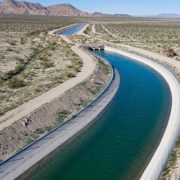Twenty years ago, in October 2003, water officials from across the Southwest signed the largest water conservation-and-transfer agreement in U.S. history, the QSA, or Quantification Settlement Agreement. The agreement has provided decades of water security for San Diego County and benefits for numerous partners across the Southwest. In total, that pact supplies more than half of the water that sustains San Diego County’s 3.3 million residents and $268 billion economy.
The 2003 QSA, provides more than 30 million acre-feet of high-priority conserved water to the San Diego region over multiple decades. It helped stabilize demands on the Colorado River and reduced California’s overdependence on surplus supplies. The historic set of more than 20 agreements resulted from years of negotiations between the San Diego County Water Authority, Coachella Valley Water District, Imperial Irrigation District, Metropolitan Water District of Southern California, State of California, and the U.S. Department of the Interior that culminated in a signing ceremony at Hoover Dam.
2003 Quantification Settlement Agreement (QSA) forged conservation model for Southwest
“This landmark water deal has stood the test of time, providing numerous benefits both in the San Diego region and more broadly across the Southwest,” said Mel Katz, chair of the Water Authority Board of Directors. “One of its most important accomplishments is that it brought water agencies together as collaborators. We’ve had disagreements along the way, but history has validated the value of our collective efforts to provide water security.”
Key components of the QSA included limiting how much water California would take from the Colorado River and a water transfer based on voluntary conservation. The agreement between the Imperial Irrigation District and the Water Authority, the cornerstone of the QSA, remains the largest agriculture-to-urban water transfer in the nation.
Conservation measures
Under the agreement, the Water Authority pays the IID to implement a variety of irrigation system and on-farm conservation measures that collectively save 200,000 acre-feet a year, which is transferred to San Diego County. Conserved water will continue to flow to the San Diego region through 2047, but that agreement can be extended through 2077 if both parties agree. (An acre-foot is about 326,000 gallons, or enough to serve three single-family homes for a year.)
In addition, the Water Authority secured $257 million in state subsidies to help pay for lining portions of the All-American and Coachella canals. As a result of those projects, the Water Authority is receiving 77,700 acre-feet of conserved water annually for 110 years.
Water-use efficiency
The QSA settled long-standing disputes over water inside California, and it provided a means to better manage the river through voluntary conservation programs and a storage program in Lake Mead. Today, the agreements continue to meet the primary goals of ensuring Colorado River water in California and the Lower Basin is put to beneficial use, that agricultural water-use efficiency improvements are adequately funded, water rights are protected, and the environment is addressed, most notably at the Salton Sea.
“The QSA, through its mutually beneficial formula of providing secure water supplies through voluntary conservation, offers a template for other regions of the Southwest as we collectively seek to live within the reduced flows of the Colorado River,” said Dan Denham, Water Authority general manager. “I’m very proud of the work we and our QSA partners have done to get to this point – and I recognize that more collaboration, resilience and vision will be needed to thrive in a hotter and drier future.”





